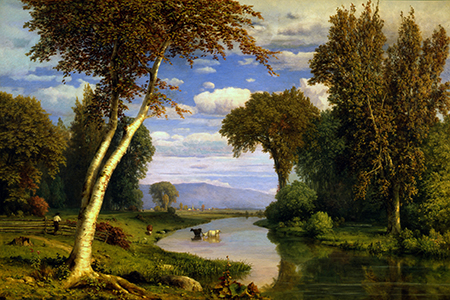Artist Bio
Inness grew up outside Newark, New Jersey, the son of an affluent family. He first exhibited at the National Academy of Design in 1844; his earliest paintings echoed the tight brushwork of the Hudson River School yet added an impressionistic element. In 1851, the young painter traveled to Italy and France, visiting the annual Salon exhibition in Paris and seeing the work of Théodore Rousseau, a leader of the Barbizon School. Inness returned to Europe two years later for a longer trip. This time, he saw more Barbizon landscapes, which had a lasting influence on his work. By 1855, Inness was painting and exhibiting works in this style. Initially ignored by the critics, his work gained a following in the 1860s.
In 1884, the American Art Galleries in New York hosted an exhibition of 57 of Inness’ paintings. Shortly after this, Inness embraced the Tonalist mode in which his paintings became more “dreamscapes” than landscapes. Colored mists fuse with blurry forms; structure and location fall away, replaced by harmonic fusion.
Join the fun at Haggin Museum!
Sign up for our e-newsletter and stay-up-to-date on all the exciting exhibitions, events & more!

